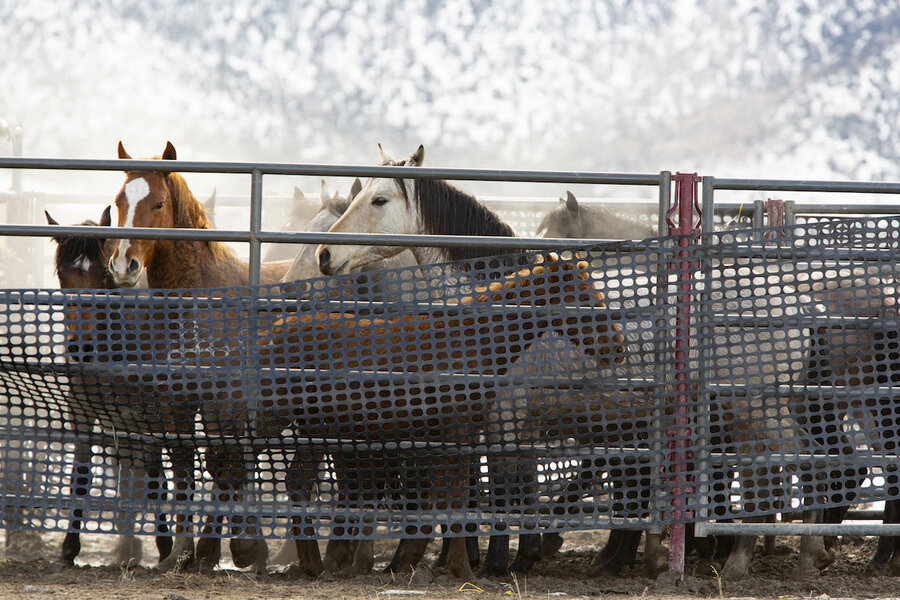Readers write: The fate of American wild horses
Our Jan. 20 cover story, “Taming a wild controversy,” elicited many reader letters. Here’s a selection of the responses.
Difficult decisions
I have been a horse lover my whole life, but I have had personal experience with seeing the consequence of too many horses on range land. Sadly, the wild and free image of wild horses overlooks the conditions where they live and try to survive. It is not so much poor range management on the part of livestock owners as the simple limitations of the environment.
During seasons of extreme drought, the desert can have devastating effects on all animals, particularly horses that suffer from lack of water and feed. The conditions on much of the range have always been short on precipitation. Parts of these regions are referred to as “deserts” for a reason.
Horses are beautiful and exciting. And if properly managed – with population control – they have an important part in the American culture and landscape. We have to decide how to control their breeding, and it might well be more humane to euthanize them when their physical conditions are compromised or there are insufficient resources for them to thrive.
Margaret Smith
Buffalo, Wyoming
Equine well-being
When I worked in Colorado in the 1980s (including on an overgrazing project), this issue of competition for grazing lands was a fierce thing. But the cattle always get what they want, because the ranchers make sure of it. They are empowered (you might say entitled) advocates.
The real issue, of course, is the welfare of these iconic horses. It’s a desperately sad situation that needs correction quickly – just like a lot of other problems in this world. To me, the cover story was interesting – I liked the story’s focus on pushing for sterilization, and that the article showed how frustrating it is for both sides – but it didn’t ignite the sense of desperation that exists for wild horse advocates.
And it went easy on the actual equine suffering. Yes, many are adopted into good homes. However, many wait in cold, muddy enclosures before being sold into what is often a tragic fate.
Considering that the horses are there because of humans, and considering the monumental positive impact horses played in American history, don’t they deserve a conscientious, kind management plan – not one that traumatizes them? It is a sad situation for both sides. But the elk – and the horses, especially – suffer the most.
Kirsten Bouchard
North Chittenden, Vermont
Editor’s note: Ms. Bouchard is related to the Monitor’s director of editorial innovation and outreach, Clayton Collins.
Alternative solutions
Once again, an excellent article outlining the problems presented in managing the feral horse problem that Americans have created as we insist on seeing them as pets rather than livestock.
However, there was no mention whatsoever of the “fertility control measure” used by all livestock managers for centuries: castration. Why is it not being done with the wild horses? Unlike the vaccine given to mares that was discussed in the cover story, castration is an operation that is minimally invasive, involves a one-time interaction, and is permanent. The gelding can live out his life in the wild and never contribute to unwanted population growth.
It probably seems more labor-intensive and a more hands-on activity than inoculation, and it’s possible that within the first few years it might be. But as the number of foals born each year drops, the job would dwindle each year. In about three or maybe four years, the job would be finished.
Judy Kurtz
Socorro, New Mexico
Subsidies from taxpayers
To me, the cover story positioned wild horses as the culprits who have enacted ecological damage that was actually done by vastly larger populations of taxpayer-subsidized cattle and sheep. I believe that the Monitor should have published a completely different kind of article – one that exposed the money ranchers receive from the U.S. government.
The Center for Biological Diversity published a 2015 report titled “Costs and Consequences: The Real Price of Livestock Grazing on America’s Public Lands.” It states: “The federal grazing subsidy is even larger when all costs to the taxpayer are accounted for. Indirect costs for livestock grazing include portions of different federal agencies budgets, such as the USDA Wildlife Services. ... The full cost of the federal grazing program is long overdue for a complete analysis.”
It’s not only Brazilian rainforests that have been destroyed by the livestock industry. It’s the American West.
Vickery Eckhoff
New York






